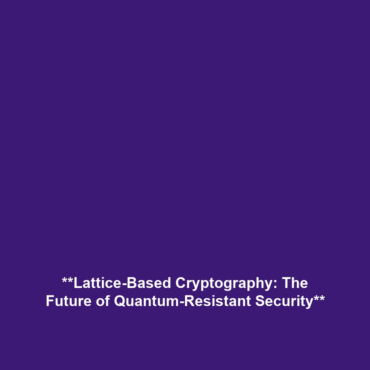Lattice-Based Cryptography: A Quantum-Resistant Solution
Introduction
Lattice-Based Cryptography represents a promising approach to secure encryption, utilizing complex mathematical structures known as lattices. As the field of Cryptography faces the imminent threat posed by quantum computing, lattice-based systems are believed to offer robust resistance against potential quantum attacks. This article will explore the foundational principles of lattice-based cryptography, its applications, challenges, and future innovations, highlighting its significance as a beacon of security in the evolving landscape of Cryptography.
Key Concepts
Understanding Lattice Problems
Lattice problems, which form the basis of lattice-based cryptography, involve computational challenges that are difficult to solve, even with advanced computing power. The most notable lattice problems include:
- Shortest Vector Problem (SVP): Finding the shortest non-zero vector in a lattice.
- Closest Vector Problem (CVP): Identifying the closest lattice vector to a given point.
- Learning with Errors (LWE): A problem that involves solving linear equations with noise, crucial for cryptographic schemes.
Resilience Against Quantum Attacks
Conventional public-key cryptographic systems, such as RSA and ECC (Elliptic Curve Cryptography), are vulnerable to quantum attacks, particularly from Shor’s algorithm. In contrast, the mathematical structures underpinning lattice-based cryptography make them less susceptible to such threats, positioning them as suitable candidates for post-quantum cryptography.
Applications and Real-World Uses
Secure Communication
One of the most significant applications of lattice-based cryptography is in secure communication protocols. It can be used to create robust digital signatures and public-key encryption methods that are secure against quantum adversaries.
Data Privacy
Lattice-based schemes are increasingly being adopted in data privacy solutions, including secure cloud computing, where sensitive information is encrypted and maintained with a strong resistance to quantum decryption efforts.
Current Challenges
Despite its promise, there are several challenges associated with lattice-based cryptography:
- Performance Overhead: Lattice-based algorithms are typically slower than traditional cryptographic methods.
- Key Size: Enhanced security often comes with larger key sizes, complicating key management.
- Implementation Complexity: The mathematical intricacies can lead to implementation challenges and vulnerabilities if not properly handled.
Future Research and Innovations
The future of lattice-based cryptography is promising, with ongoing research aimed at optimizing performance and reducing overhead. Innovations include:
- New Algorithms: Exploring more efficient algorithms that maintain security while enhancing performance.
- Integration with Existing Systems: Developing methods to integrate lattice-based cryptography into current infrastructure seamlessly.
- Standards Development: Establishing universal standards for implementing lattice-based cryptographic schemes in various applications.
Conclusion
Lattice-Based Cryptography stands at the forefront of securing data against the impending quantum computing revolution. Its unique properties make it an essential component of future cryptographic solutions. As research and development continue, we encourage readers to explore further resources on the significance of lattice problems and their applications in modern cryptography. For more information on cryptography standards and techniques, visit our comprehensive guide.
